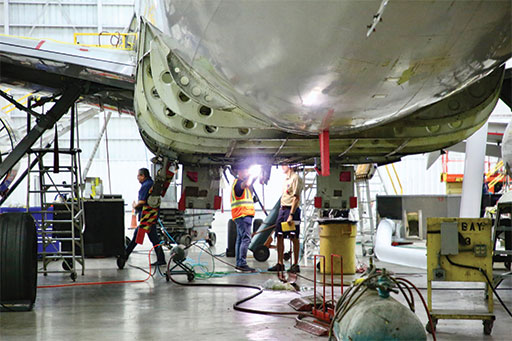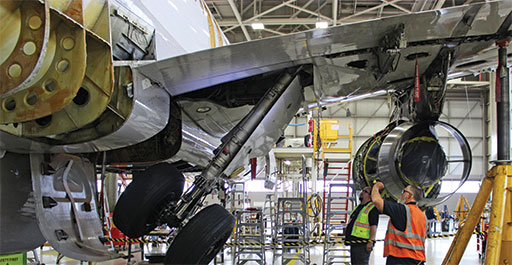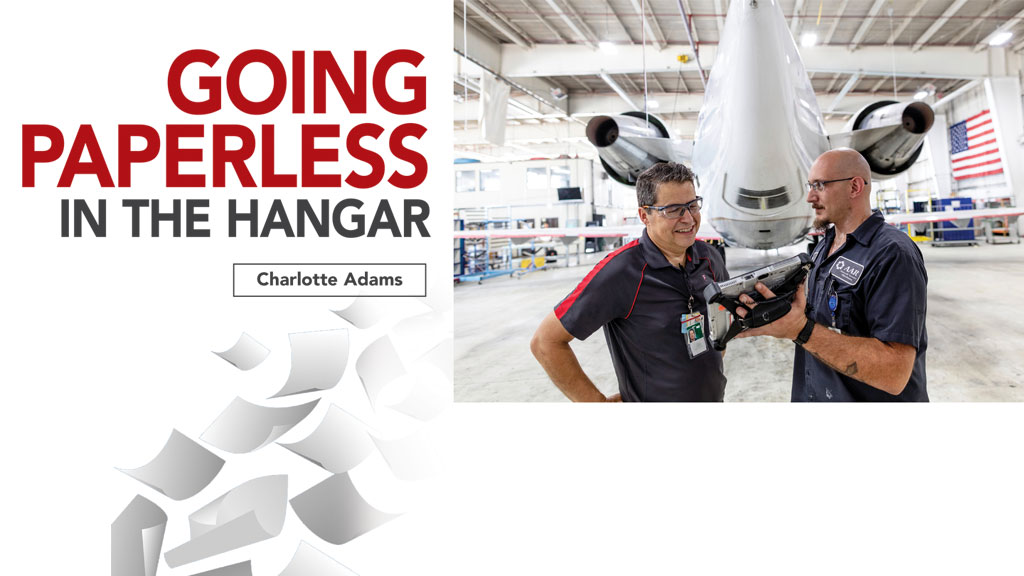In their highly regulated environment MROs often rely on paper to document compliance to the authorities and job performance to customers. Some paper documents are required by regulators, and paper is the preferred medium of some lessors and customers.
But now environmental as well as business concerns point toward paperless. IATA is calling for paperless transformation while assuring aviation safety, security, and environmental sustainability. Although many leading players have embraced software solutions that boost efficiency and reduce waste, much more can be done.
AAR’s Brian Sartain, senior vice president of repair and engineering services agrees that there is a renewed urgency for MRO businesses to focus on environmental concerns. “Companies and consumers across industries have an increased focus on sustainability,” he says. “Internal digitization and reducing our usage of natural resources like energy, paper and water are important to us, and we have made quite a few strides in our MRO network, particularly.”
U.S. repair stations are a “kind of untapped market” for the software, asserts Pete Sasson, an MRO veteran and software specialist who recently founded PG Air, a software consulting firm. Apart from the rare case of a perfect paper process, it’s advantageous to go paperless no matter what size you are because it drives so many other efficiency improvements, he says.
Bad Wrap?
“Paper-centric processes can be efficient and cost-effective when applied properly,” says Allan Bachan, managing director of MRO operations at the consultancy, ICF. What’s more, electronic and digital methods have their own challenges. Both actually can be more costly and inefficient depending on how they support MRO, he says. “In fact, we have seen digital methods mirror paper processes rather than replace [them] in many instances, thus adding to overall costs and inefficiencies.”

However, MRO AAR says going paperless would increase their efficiency and reduce waste, which are key objectives in their sustainability plan. “The ability to electronically sign off work cards will cut a significant amount of administrative time in MRO operations,” says AAR’s Sartain. “Eliminating the use of paper and other environmentally impactful materials is a priority always.” Sartain says eliminating time in administrating paper will lead to a direct improvement in profitability since more time can be spent working on the aircraft instead of shuffling paper. AAR believes that improvements will be in the 5-10 percent range. MRO Software provider ULTRAMAIN concurs, saying the true benefit of paperless is that MROs won’t need to make the efficiency vs. environment decision. These two things simply go hand in hand.


Most MROs still use paper as the basis for routing work cards and documents that require official sign off for regulatory officials, Sartain says. “We do believe that we can increase our efficiency approximately 10 percent through the elimination of paper work instructions,” he adds.
“Paper centricity in aviation MRO operations continues to be contingent on the need for documented compliance — regulatory, legal, and financial,” agrees Bachan.
“At this point, aviation authorities do not encourage or discourage paperless operations per se, but they most certainly do have regulations pertaining to them and digital records,” says John Stone, vice president of product management, for ULTRAMAIN. “They need to because when the system of record is purely digital, operators and regulators need to know the integrity of the system is uncompromised.”
Historically, paper records were used to route parts through the process, and operators could stamp and record completion. This paper becomes an official maintenance record that needs to be kept in a safe place, explains Alejandro Mayoral, senior vice president, information technology, for StandardAero. Canada’s Form 1 — for release to service — remains a paper requirement by regulation, according to AJW Technique.
In the leased or mortgaged aircraft/engine ecosystem — more than 65 percent of the world’s airplanes and engines — paper is still “the most common data source for maintenance records,” Bachan says. “Cross-border transfers and registrations of aircraft require perusal, audits, and detailed reviews of these records to assess asset worth, airworthiness, and ownership status.” It’s just “an ongoing reality that owners and lessors still need to have ‘dirty fingerprint’ records, which may also be scanned, processed, and managed as digital images,” Bachan says.
Full-cycle and holistic paperless MRO operations are still at least 10 years away, he adds. “Until regulators, lessors, owners, and operators agree on the many supporting protocols, solutions will be confined to select process elements and stakeholders.”
Low-Hanging Fruit
Paper-centered processes can be difficult to scale. Inefficiencies start with the MRO having to print and sort the task cards for its engineers, says ULTAMAIN’s Stone. “This is a big process…sometimes filling rooms full of [boxes of] paper, because the number of task cards is so large.” Task cards include approved checks but also other tasks stemming from service bulletins, airworthiness directives, and engineering orders, as well as deferred maintenance items. “With ULTRAMAIN the entire process is paperless,” Stone says. “Upon receiving electronic pdf task cards from the airline, an MRO using ULTRAMAIN auto ingests them where many thousands of task cards can be auto-scanned very quickly. As part of the scanning/uploading process, ULTRAMAIN separates the data from the rendering of the data where each card becomes data separate from how the pdf card looks.”
Paper can’t be key word-searched and must be stored. It’s very time-consuming, for example, to assess the effectiveness of your maintenance program by reviewing paper records, says Daragh Cunningham, senior director, AMOS Americas. AMOS is developed and maintained by Swiss AviationSoftware, which is owned by Swiss International Airlines and part of the Lufthansa Group.
Completing documentation for paper-based operations can take weeks after the work is done and certifying that all work was accomplished by properly certified and current engineers. “Airlines will not pay without such documentation,” Stone says. “This happens is real time with ULTRAMAIN because it won’t assign work to unqualified staff or accept signoffs from unqualified engineers or inspectors. The audit trail is created as the work is done. Clear, simple, and nonrefutable.”
Historically MRO operations have required a large amount of paper, Mayoral says. “One single component or an engine would have multiple records associated with it, covering logbooks, routers, certificates, inspection records, etc. … Producing, managing, storing, and retrieving [paper documents] are labor-intensive [processes].”
AAR says they are using less paper currently than in years past. “Most MROs are looking at prints and technical documentation through the use of revision-controlled electronic documents instead of printing them out,” according to Sartain. “I think that U. S. airlines and MROs are not as far along in digitization as European MROs due to the costs involved in going paperless and the requirements for regulatory compliance.”
ULTRAMAIN’s Stone says going paperless brings large efficiency gains and related cost savings, which is justification enough for MROs and airlines to switch to paperless operations. “Efficiency goes up, profits goes up, quality goes up, safety goes up, as does customer satisfaction. Regulators are all for systems that improve safety and auditability,” he adds.
Paper Footprint
AAR believes virtually all the tasks that are carried out in the hangar can be digitized, but acknowledges the systems required to make these digital documents official in the eyes of customers and regulatory authorities are quite expensive and difficult to implement. “AAR has digitized delivery of technical documentation and is piloting systems that would enable a completely paperless work package with our customers currently,” Sartain says.
Some aircraft checks require 400 to 500 task cards, involving up to 600 pieces of paper, Sasson says. Multiply those 600 pieces of paper by four or five checks a night, and you’re talking about “reams and reams of paper.” Printing, organizing, binding, and distributing all this paper might take maintenance planners an entire day. Sasson has implemented AMOS maintenance software for several airlines, and is working with cargo carrier, USA Jet, and other airlines and maintenance organizations.

PG Air image.
Some paper manuals are low-hanging fruit for electronic conversion, both to streamline processes and reduce waste, Sasson says. The minimum equipment list (MEL) manual, for example, at some airlines might be 1,000 pages long, multiplied by the number of pilots, managers, and directors who need copies.
777: Paperless Airplane?
The Boeing 777 was in production in 1995. “No paper was used to design and produce that aircraft,” says Allan Bachan, managing director of MRO operations at the consultancy, ICF. So the opportunity to maintain a digital — fully paperless — thread for each aircraft coming off the production line has existed for the last 24 years.”
There are an estimated two million part numbers making up the 777, he says. “If we conservatively assume one sheet of paper for each, then that’s how much paper was eliminated” by Boeing at the front end. “The irony is that the management of each aircraft throughout its lifecycle will incur an estimated 10 times that (design) volume of paper.”
Managing changes to the massive paper manual can be complicated because it involves both airline operations, which owns and revises it, and maintenance, which also uses it. Every change has to be printed and distributed to maintenance, as well as signed for by that department, so their copy is not found to be out of date when the FAA pays a call.
An airline’s maintenance program manual is also a good candidate for conversion, Sasson says. These manuals — which spell out a carrier’s maintenance procedures — can be “a couple thousand pages long.”
“Paper introduces many inefficiencies,” agrees James Elliott, senior business architect, aerospace & defense, for IFS, the provider of Maintenix MRO software. Examples are “time spent on data entry, inaccurate re-keying of information from paper into the maintenance information system [MIS], and inefficient search and retrieval.”
Elliott asserts that “paper in any process is a bottleneck,” as it is a “single-user medium.” He cites the case of a plane full of passengers that must wait until “the mechanic fills out a paper form, walks it to the cockpit for a captain’s signature, and then returns it to maintenance operations.” The cash and goodwill cost can be significant, he says. The right software can make the entire process digital, faster and even safer.
Is Going Green a Bunch of Hogwash?
Aviation Maintenance took a deeper dive into the environmental aspects of going paperless with John Stone, ULTRAMAIN’s vice president of product management. We asked Stone if it is possible for MROs to eliminate paper 100 percent and what difference that would make to the environment. Since most discarded paper in the U.S. goes into landfills and does not biodegrade or return CO2 to atmosphere and tree harvesting is mitigated by replanting, is there truly a benefit? Here is what he had to say:
Any MRO or airline that transforms paper processes to digital processes will completely eliminate paper in such processes. But until the industry as a whole goes paperless 100 percent elimination of paper is probably not a realistic expectation.
Regarding what difference would it make to the environment to eliminate paper use, that’s an interesting question. All life on earth is carbon-based so we are never eliminating that — ever, but people do wish to reduce CO2 in the atmosphere, and measures can be taken to do that. The question is, is elimination of paper one that helps?
Trees (and plants) are not only beneficial, they are necessary and critical because they absorb CO2 and emit O2. By and large paper pulp is produced from farmed trees today (planted and harvested trees) not natural forest trees, so production of paper does not remove trees from the planet. Just the opposite, the more tree farms that exist, that would not otherwise exist except due to paper pulp production, the more CO2 is removed from the atmosphere and the more O2 is produced.
In light of tree farms one can make an argument that the more that paper is used the more tree farms will exist and consequently the more CO2 will be removed from the air. Regardless, whether a tree is harvested for paper production or grows old, dies, and decays in a forest, in the end it existed in the ecosystem. In doing so does a tree absorb more CO2 during its life than it returns as it decays after it dies? Paper ends up in landfills, no doubt about it, but it is also recycled to make other paper products. How many times can that be done for a given piece of paper? What impact does that have? How much energy is needed to do it? What’s the net effect of all of this overall? Opinions vary.
What we do know is that oxygen makes up 21 percent of our atmosphere where CO2 makes up less than one half of one percent (.04 percent) so CO2 makes up a very small percentage of the atmosphere. Furthermore, of the small percentage of CO2 in the atmosphere, how much comes from biodegrading trees/paper? Any at all? Considering it all, how much meaningful reduction in CO2 in the atmosphere can be realized by not using paper vs using paper? Environmentally speaking, does not producing and using paper matter? Does not growing tree farms matter?
If you look at how much CO2 is generated by shipping, flying, and trucking paper to where it’s used, reducing its use would undeniably reduce CO2 in the atmosphere generated from transporting it. One would think just doing that would be valuable in reducing CO2 in the atmosphere.
Duncan Aviation
Although paper is far from the worst ecological issue in the aviation industry, it’s an issue that can be mitigated via software systems that force process redesign.
There are many ways to reduce paper footprint. Bizjet MRO, Duncan Aviation, developed electronic work order and signoff systems back in 2007, says Rich Teel, IT systems and programming manager for the company.
In addition to its business advantages, the software probably saves at least half a million pieces of paper a year, Teel estimates. That’s just counting the work order header pages and associated paperwork for the more than 50,000 work orders the MRO processes every year. The savings are actually much more than that since many other activities now documented in the software previously required paper, he says.
Duncan Aviation also plans to roll out a new version of its work order system that can run on a smart phone, he says. Technicians will be able to document and sign off on their work using phones, instead of having to get out of an airplane and go to a computer terminal, because the new process will not require a badge swipe.
The new system also will allow mechanics at all of the MRO’s satellite locations, as well as its rapid response teams, to sign off on work via their phones. They won’t have to look for a computer that’s hooked up to the company’s network. The new system will allow them to use a browser-based application to communicate with the work order system.
Maintenix
Qantas and Executive Jet Management (EJM), longtime Maintenix customers, are ahead of the paper curve, Elliott says. Qantas has been on board for a decade and Executive Jet Management (EJM), a bizjet charter operator, went live with an FAA-certified solution in 2008.
EJM’s implementation of e-signature translated into environmental as well as business gains. “A typical work order for EJM might be 200 pages long,” Elliott says.
“A mechanic might have to flick through every single page just to identify the open tasks and then make that into a separate list for the next shift. That might take 20-30 minutes and it could be easy to miss things,” he says.
The company estimates that the efficiencies within shift turnover activities alone save up to 10 labor hours each day. It also attributes a 60 percent reduction in work package setup time and nearly $400,000 in yearly labor cost savings to the solution.
AJW Technique
AJW Technique uses around 150 boxes of paper per year, says Sajedah Rustom, CEO. But this has already been reduced significantly, as technician manuals are now electronic. “We would expect potentially a further 30 percent reduction related to future digitization projects,” she says.
The Canadian component MRO recently completed a day-long assessment of shop floor processes — from receiving all the way through the final production process — in order to identify opportunities to go digital and paperless, Rustom says. “I want technicians to spend most of their time touching components and repairing them,” versus doing paperwork. This is an environmental issue but also an efficiency issue, she says.

AJW Technique is looking at technologies such as bar coding, voice recognition, data analytics, and AI to increase efficiencies and reduce paper usage. She expects bar coding to speed up the induction process, for example. Voice recognition could be helpful in initial diagnostics, and AI and more advanced technologies could play a role in areas such as the costing of work — if the same workscopes on the same part types have been performed on a frequent basis. Rustom expects to have made significant progress on the paperless initiative by mid-2020.
Hurdles
Major obstacles to going paperless involve “the vast maturity gaps with technology adoption and readiness in the operator and MRO ecosystems,” Bachan explains. “Practically all [MRO] tasks can potentially be made fully digital” — from source publications through to work instructions and signed-off tasks proving compliance.
“Electronic signature is probably the biggest hurdle,” Sasson says. Because everything is called out in maintenance manuals, adopting e-signature involves a “pretty intensive revision” to the manuals plus regulatory approval. This is manpower-intensive, which makes it difficult for lean-running U.S. MROs. AMOS and Maintenix provide this function.
Another paper-intensive area is OEM documents, Cunningham notes. In the hangar mechanics often print relevant pages from the aircraft maintenance manual (AMM). After a task is completed, that paper has to be thrown out because of AMM revision control. “Mechanics can’t just keep a copy of an AMM section in their pocket” and reuse it another time, he says. OEMs revise manuals frequently, so mechanics have to check the AMM each time they prepare to do anything.
Without a mobile version of the manual, the mechanic has to use paper. You have to print the task card and a 2-10-page section of the AMM. AMOS can be used on any mobile device, he says.
Maintenix also supports maintenance operations, including e-signatures, on mobile devices, Elliott says.
Duncan Aviation’s electronic signoff is essentially an electronic signature, Teel says. The MRO also has a project with CAMP Systems, the maintenance tracking company. “They used to send us hundreds of inspection items required for each job” in paper format, Teel says. The MRO is working on downloading that data electronically into its work order system instead. (A single inspection can involve hundreds of pieces of paper.) So on the MRO side technicians are in effect filling out CAMP’s task cards electronically rather than manually, and the data is being stored in the MRO’s computer systems. Teel estimates this will save at least 300,000 pages of paper a year.
Yet conversion to mobile is not widespread. Recent IFS research on commercial aviation mobility showed that only 17 percent of respondents could access an entire enterprise software suite on a mobile device, Elliott says.
The study results show that overall, only 31 percent of respondents regularly accessed their enterprise software using a mobile device. Of the respondents that stated they could access enterprise software using a mobile device, only 14 percent could access all functionality in this fashion, while the remaining respondents could access some modules of a suite but not others.
AJW Technique is looking at electronic data interchange (EDI) for paperless exchanges of quotes with its customers. The MRO is also reaching out to its supply chain, both the component OEMs and smaller, local suppliers, Rustom says. “It could be something as simple as a data link.” AMOS also enables data exchange between customers and third-party partners, thanks in part to EDI standards defined by IATA.
In all probability, however, some paper will remain. One example is engine logbooks, which need to accompany engines that are sent out to third-party shops, Sasson says.
“There may still be printed information in the form of labels or other types of identification, … which would travel with the components through the maintenance process,” Mayoral adds.
Others point out that viewing AMMs on a mobile device might not be a good experience on a tiny screen, so that printing pages from the manual may remain a common practice.
